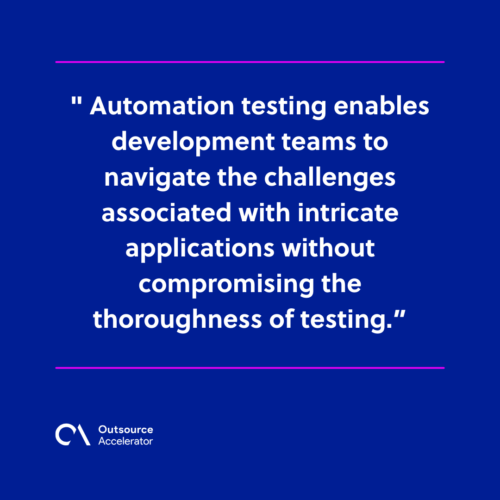A closer look at the benefits of automation testing

As technology advances, software systems become more complex.
Rapid programming language and methodologies changes create a dynamic environment challenging traditional testing methods.
For instance, manual testing, which was once dominant, is time-consuming and error-prone.
Hence, the need for faster development cycles and the growing application complexity necessitate a shift towards more streamlined software testing solutions.
One solution that has gained prominence in recent years is automation testing.
What is automation testing?
Automation testing uses tools and scripts to execute test cases and verify predefined actions in a software application.
Unlike manual testing, which relies on human intervention to perform test cases, automation testing streamlines the process through automated scripts.
These scripts simulate user interactions, enabling the efficient identification of defects, performance issues, and other aspects that may impact the software’s functionality.

Manual vs. Automated testing
Understanding the differences between manual and automated testing is crucial to realizing the respective benefits of automation testing later on.
Manual testing relies on human testers to execute test cases, observe and evaluate the software’s behavior, and report defects or issues.
While manual testing is essential for exploratory testing and accessibility evaluation, it can be:
- Time-consuming
- Prone to errors
- Challenging to scale
On the other hand, automation testing leverages scripts and testing tools to execute test cases. It reduces human intervention and increases the efficiency of the testing process.
Benefits of automation testing
Automation testing isn’t just a solution; it’s a strategic evolution in software testing. It seamlessly aligns with the demands of modern development cycles.
The benefits of automation testing make software analysis indispensable in pursuing efficient, reliable, and high-quality software.
Let’s explore these advantages in detail:
Increased speed of testing processes
Automation testing presents a quantum leap in efficiency compared to its manual counterpart.
This means that the automated tests operate at a remarkable speed, outpacing manual tests’ time-consuming nature.
In agile development, swift and reliable testing is vital due to the iterative nature of development.
The feedback loop tightens with automation, allowing development teams to identify and rectify issues rapidly. This is one of the most vital benefits of automation testing that ensures a seamless and expedited software development life cycle.
Consistent and repeatable test execution
Automation testing introduces precision and consistency, which is challenging with manual testing. Automated scripts execute test cases with unwavering uniformity. It ensures that the same sequence of actions is repeated each time a test is conducted.
One of the most significant benefits of automation testing is that it minimizes the risk of overlooking potential issues and fosters confidence in the software’s stability.

Parallel execution for faster results
In manual testing, the sequential nature of tasks, reliant on human testers, often becomes a bottleneck in pursuing swift results. Automation testing, however, breaks free from this limitation by enabling the simultaneous execution of test cases across multiple devices.
The acceleration achieved through parallel execution aligns with the demands of agile development and enhances the testing phase’s overall responsiveness.
This is one of the most critical benefits of automation testing that will enable your teams to iterate quickly and release high-quality software.
Enhanced test coverage
Another one of the important benefits of automation testing is its ability to enhance the overall test process.
Automation testing can create a broad suite of test cases covering diverse functionalities and scenarios. It ensures that no data is left unturned in identifying potential defects.
The expansive test coverage provided by automation spans different parts of the application, scrutinizing its various facets and functionalities. This meticulous examination translates into a more robust and reliable software product.
Automation testing empowers development teams to deliver software that exceeds users’ expectations and fosters confidence in the application’s functionality.
Early detection of defects in the development cycle
Automation testing seamlessly integrates automated tests into the continuous integration and continuous delivery (CI/CD) pipeline. This enables development teams to gain immediate insights into the repercussions of code changes.
This is among the most compelling benefits of automation testing that proves instrumental in minimizing the likelihood of issues escalating into more complex problems.
The rapid feedback loop provided by automation testing enables developers to pinpoint and rectify defects at their developing stages.
As a result, it significantly reduces the overall cost and effort associated with bug fixes.
Improved scalability for large and complex applications
Automation testing enables development teams to navigate the challenges associated with intricate applications without compromising the thoroughness of testing.
As the demands on testing increase, automation testing rises to provide a robust framework that can handle the intensifying workload. Scalability becomes especially crucial in agile development environments.
Furthermore, the benefits of automation testing ensure that testing processes remain agile, adaptive, and capable of meeting the demands of even the most expansive software applications.

Reap the benefits of automated testing
From increased testing speed and consistent test execution to enhanced coverage and early defect detection, the benefits of automation testing are indeed compelling.
This heightened speed will benefit your team, especially if you’re in an industry that adheres to agile development methodologies.
If you’re still using manual testing, now is the time to incorporate automation into your development processes.
Reap the benefits of automation testing and accelerate your testing cycles!







 Independent
Independent




